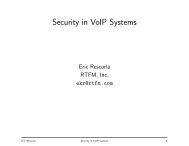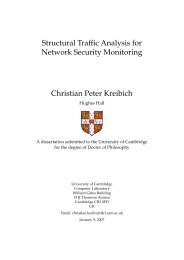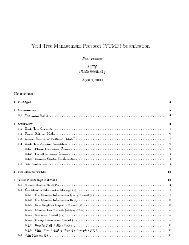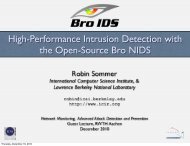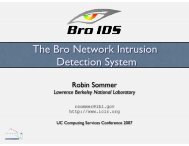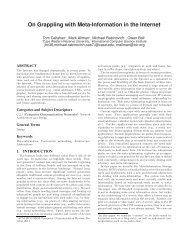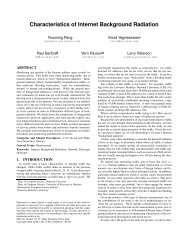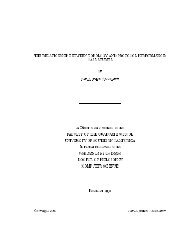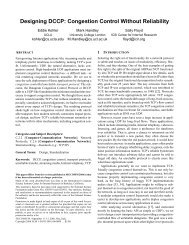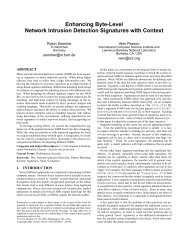SIFF: A Stateless Internet Flow Filter to Mitigate DDoS Flooding Attacks
SIFF: A Stateless Internet Flow Filter to Mitigate DDoS Flooding Attacks
SIFF: A Stateless Internet Flow Filter to Mitigate DDoS Flooding Attacks
You also want an ePaper? Increase the reach of your titles
YUMPU automatically turns print PDFs into web optimized ePapers that Google loves.
<strong>SIFF</strong>: A <strong>Stateless</strong> <strong>Internet</strong> <strong>Flow</strong> <strong>Filter</strong><br />
<strong>to</strong> <strong>Mitigate</strong> <strong>DDoS</strong> <strong>Flooding</strong> <strong>Attacks</strong> ∗<br />
Abraham Yaar Adrian Perrig Dawn Song<br />
Carnegie Mellon University<br />
{ayaar, perrig, dawnsong}@cmu.edu<br />
Abstract<br />
One of the fundamental limitations of the <strong>Internet</strong> is the<br />
inability of a packet flow recipient <strong>to</strong> halt disruptive flows<br />
before they consume the recipient’s network link resources.<br />
Critical infrastructures and businesses alike are vulnerable<br />
<strong>to</strong> DoS attacks or flash-crowds that can incapacitate their<br />
networks with traffic floods. Unfortunately, current mechanisms<br />
require per-flow state at routers, ISP collaboration,<br />
or the deployment of an overlay infrastructure <strong>to</strong> defend<br />
against these events.<br />
In this paper, we present <strong>SIFF</strong>, a <strong>Stateless</strong> <strong>Internet</strong> <strong>Flow</strong><br />
<strong>Filter</strong>, which allows an end-host <strong>to</strong> selectively s<strong>to</strong>p individual<br />
flows from reaching its network, without any of the<br />
common assumptions listed above. We divide all network<br />
traffic in<strong>to</strong> two classes, privileged (prioritized packets subject<br />
<strong>to</strong> recipient control) and unprivileged (legacy traffic).<br />
Privileged channels are established through a capability exchange<br />
handshake. Capabilities are dynamic and verified<br />
statelessly by the routers in the network, and can be revoked<br />
by quenching update messages <strong>to</strong> an offending host. <strong>SIFF</strong> is<br />
transparent <strong>to</strong> legacy clients and servers, but only updated<br />
hosts will enjoy the benefits of it.<br />
1 Introduction<br />
Despite a significant breadth of research in<strong>to</strong> defenses,<br />
Denial of Service (DoS) attacks remain a significant problem<br />
in the <strong>Internet</strong> <strong>to</strong>day. The DoS phenomenon has<br />
evolved rapidly over the last decade. DoS attacks were<br />
∗ This research was supported in part by the Center for Computer and<br />
Communications Security at Carnegie Mellon under grant DAAD19-02-<br />
1-0389 from the Army Research Office, and by gifts from Bosch, Cisco,<br />
Intel, and Matsushita Electric Works Ltd. The views and conclusions contained<br />
here are those of the authors and should not be interpreted as necessarily<br />
representing the official policies or endorsements, either express or<br />
implied, of ARO, Bosch, Carnegie Mellon University, Cisco, Intel, Matsushita<br />
Electric Works Ltd., or the U.S. Government or any of its agencies.<br />
once caused by only a few attackers—often only a single<br />
attacker—sending specially crafted packets designed <strong>to</strong> exploit<br />
flaws in the victim’s particular TCP/IP implementation<br />
(e.g., the Teardrop or Land Attack), and sometimes using IP<br />
spoofing [10] (the forging of the source IP address field in<br />
the IP header <strong>to</strong> something other than the sending host’s IP<br />
address) <strong>to</strong> hide their identity. DoS attacks are becoming an<br />
increasing risk, as the sophistication of current attack <strong>to</strong>ols<br />
enables relatively inexperienced attackers <strong>to</strong> perform these<br />
attacks.<br />
As the number of systems connected <strong>to</strong> the <strong>Internet</strong> has<br />
increased, the black-hat community has developed <strong>to</strong>ols<br />
(known as root-kits) that take advantage of security flaws<br />
in operating system services <strong>to</strong> compromise computers. The<br />
black-hat community has also written <strong>to</strong>ols designed <strong>to</strong> control<br />
and coordinate these exploited machines (often called<br />
zombies) on a large scale [13, 14]. These developments<br />
have given rise <strong>to</strong> a new type of DoS classification: the distributed<br />
DoS attack (<strong>DDoS</strong>). These attacks tend <strong>to</strong> be different<br />
from simple DoS attacks in that the attacks are composed<br />
of compromised hosts that are not easily traceable <strong>to</strong><br />
the machine controllers themselves. For this reason, <strong>DDoS</strong><br />
attackers are not concerned with spoofing as a disguising<br />
tactic; they merely use it <strong>to</strong> bypass potential IP address filters<br />
or <strong>to</strong> involve unwitting third parties in the attack as traffic<br />
amplifiers [34]. Furthermore, because of the sheer number<br />
of hosts involved, (there have been reports of groups<br />
claiming over 140,000 compromised hosts under their control<br />
[11]), the attacks tend <strong>to</strong> work simply by flooding packets<br />
on<strong>to</strong> the network, which converge upstream from the<br />
intended victim and disrupt the infrastructure, <strong>to</strong> prevent or<br />
reduce legitimate access <strong>to</strong> the victim.<br />
The <strong>DDoS</strong> flooding problem is particularly difficult <strong>to</strong><br />
defend against, because the very architecture that has fueled<br />
the <strong>Internet</strong>’s growth—reliance on intelligent end-hosts<br />
connected by a relatively simple network (the end-<strong>to</strong>-end<br />
principle)—is used <strong>to</strong> the attacker’s advantage. In this network<br />
architecture, any host in the network can send a packet<br />
1
<strong>to</strong> any destination address (even if the destination does not<br />
want <strong>to</strong> receive the packet), and the destination has no<br />
way of s<strong>to</strong>pping those packets before they reach it (or its<br />
network). Although many innovative avenues of defense<br />
against DoS and <strong>DDoS</strong> have been explored in the literature<br />
(we review some of these in the next section), only a few<br />
of the approaches even address the <strong>DDoS</strong> flooding problem.<br />
In this paper, we explore the design issues involved<br />
in constructing a system from scratch that solves the <strong>DDoS</strong><br />
flooding problem by giving a packet receiver control over<br />
which packets the network delivers <strong>to</strong> it.<br />
1.1 Related Work<br />
Several researchers have studied the frequency and nature<br />
of <strong>Internet</strong> DoS attacks [16, 17, 21, 24, 31]. In this<br />
section, we review related work in the area of <strong>Internet</strong> DoS<br />
defenses. We distinguish the research in<strong>to</strong> two general areas:<br />
defending against IP source address spoofing, and defending<br />
against bandwidth flooding attacks.<br />
We first discuss research in defenses against source IP<br />
address spoofing. Ferguson and Senie propose <strong>to</strong> deploy<br />
network ingress filtering <strong>to</strong> limit spoofing of the source IP<br />
address [15]. Burch and Cheswick propose <strong>to</strong> use a limited<br />
form of DoS attack <strong>to</strong> probe which links are affected<br />
by an attack and can thus trace back <strong>to</strong> the origin [8]. Park<br />
and Lee propose a distributed packet filtering (DPF) mechanism<br />
against IP address spoofing [32]. DPF relies on BGP<br />
routing information <strong>to</strong> detect spoofed IP addresses.<br />
Bellovin et al. suggests adding a new type of ICMP message<br />
for traceback [6], and Mankin et al. present an improvement<br />
<strong>to</strong> this scheme [28]. Several researchers propose<br />
<strong>to</strong> embed traceback information within the IP packet [2, 12,<br />
19, 26, 35, 38, 43]. Most of these schemes use the 16-bit IP<br />
Identification field <strong>to</strong> hold traceback information. Routers<br />
along the packet’s path probabilistically mark bits in the<br />
IP Identification field in different ways. While traceback<br />
schemes could be used <strong>to</strong> find the origins of the attacks,<br />
they often require a large number of packets and cannot be<br />
used <strong>to</strong> filter out packets on a per-packet basis.<br />
Snoeren et al. propose a mechanism using router state <strong>to</strong><br />
track the path of a single packet [37]. Their approach enables<br />
a victim <strong>to</strong> trace back a single packet by querying the<br />
router state of upstream routers. In earlier work, we propose<br />
the Pi marking scheme <strong>to</strong> enable the victim <strong>to</strong> detect<br />
packets with a spoofed source IP address [47]. Pi is not effective<br />
against bandwidth flooding attacks because it relies<br />
on victim filtering of <strong>DDoS</strong> traffic and bandwidth flooding<br />
typically causes damage (i.e., dropped packets) upstream<br />
from the victim.<br />
The IP traceback and spoofing defenses we discussed<br />
so far, defend against <strong>DDoS</strong> at the victim of the attack.<br />
The research most closely related with our work attempts<br />
<strong>to</strong> defend against network flooding attacks in the network<br />
itself. S<strong>to</strong>ne proposes the CenterTrack mechanism, which<br />
uses routers capable of input debugging (the ability <strong>to</strong> determine<br />
through which router interface a particular packet<br />
was received) that would be virtually connected through IP<br />
tunnels <strong>to</strong> all border routers on a network [42]. When a node<br />
in the network comes under attack, the overlay network is<br />
activated, and all border routers channel traffic through the<br />
overlay routers. These routers would use input debugging <strong>to</strong><br />
determine from which border router, and hence from which<br />
neighbor network, the <strong>DDoS</strong> traffic is coming from. However,<br />
this technique requires that the ISP create the overlay<br />
network and perform filtering, and may not be practical for<br />
large attacks.<br />
Generalized network congestion control is related <strong>to</strong><br />
<strong>DDoS</strong> defense. Ioannidis et al. propose Aggregate Congestion<br />
Control (ACC)/Pushback, which leverages router support<br />
<strong>to</strong> rate-limit groups of similar packets responsible for<br />
congestion, and push filters upstream <strong>to</strong>wards the sources<br />
of those packets <strong>to</strong> preserve network bandwidth [22, 27].<br />
ACC/Pushback requires non-negligible state at routers and<br />
faces challenges in attack traffic identification and ISP interoperation.<br />
S<strong>to</strong>ica et al. propose a mechanism for <strong>Stateless</strong><br />
Fair Queueing (SFQ) in the network core [40]. Their<br />
scheme has edge routers maintain per-flow arrival-rate information.<br />
Edge routers label packets based on their flow’s<br />
rate information, and core network routers use probabilistic<br />
dropping based on the packet labels <strong>to</strong> fairly distribute<br />
bandwidth among flows. SFQ requires that the malicious<br />
flows’ edge routers implement the labeling, so that those<br />
flows can be rate limited in the core.<br />
Researchers recently investigated using overlay networks<br />
<strong>to</strong> mitigate the effect of DoS attacks. Keromytis et<br />
al. designed the Secure Overlay Services (SOS) architecture<br />
<strong>to</strong> proactively defend against DoS attacks [25]. SOS<br />
uses an overlay network <strong>to</strong> authenticate users and installs<br />
filters at the ISP level. Anderson generalizes the SOS architecture<br />
by considering different filtering techniques and<br />
overlay routing mechanisms and proposes Mayday [4]. Adkins<br />
et al. propose the use of the <strong>Internet</strong> Indirection Infrastructure<br />
(i3) [39] <strong>to</strong> enable the victim <strong>to</strong> s<strong>to</strong>p individual<br />
flows by removing the unique forwarding pointer that each<br />
sender possesses [1]. An advantage of these techniques is<br />
that they do not require changing the current <strong>Internet</strong> infrastructure.<br />
However, they assume presence of an overlay<br />
infrastructure, they require per-flow state in the overlay network,<br />
and they assume updated client and server software<br />
and pro<strong>to</strong>cols.<br />
Mirkovic et al. propose D-Ward, an au<strong>to</strong>mated system<br />
that detects flooding attacks on a link and au<strong>to</strong>matically installs<br />
filters [29]. In their system, the receiver has no control<br />
over these filters, and so the receiver has no way of s<strong>to</strong>pping<br />
a widely distributed flooding attack or choosing flows<br />
2
it wants <strong>to</strong> serve in case of a flash crowd [24]. Jamjoom<br />
and Shin propose persistent dropping for dealing with flash<br />
crowds [23]. Their drop policy preferentially drops TCP<br />
SYN packets in favor of preserving ongoing TCP flows, but<br />
does not deal with DoS attacks that may flood with traffic<br />
other than TCP SYNs.<br />
Our <strong>SIFF</strong> pro<strong>to</strong>col or a capability-based approach that<br />
uses per-flow state can easily be implemented in a secure<br />
active network environment [3].<br />
Anderson et al. present a capability-based approach,<br />
where a sender first needs <strong>to</strong> obtain a capability from the infrastructure<br />
<strong>to</strong> send traffic <strong>to</strong> a receiver [5]. Their approach<br />
is similar <strong>to</strong> ours, but requires per-flow state at each router.<br />
Gligor analyzes various mechanisms for filtering excessive<br />
connection establishment requests [18]. Assuming that<br />
the network connections are not saturated, he analyzes the<br />
waiting time guarantees that various puzzle and client challenge<br />
techniques provide and comes <strong>to</strong> the intriguing conclusion<br />
that puzzles are not useful <strong>to</strong> provide any guarantees<br />
of waiting time.<br />
In contrast <strong>to</strong> these previous approaches, the mechanisms<br />
we present in this paper provide the victim of a flooding attack<br />
(or a server in the case of flash crowds) <strong>to</strong> select individual<br />
traffic flows that it wants <strong>to</strong> s<strong>to</strong>p, without requiring<br />
per-flow state in the network (in fact, without contacting<br />
any routers or ISPs), while still enabling legacy clients or<br />
servers <strong>to</strong> communicate with updated servers or clients.<br />
1.2 Organization<br />
The remainder of our paper is composed as follows: in<br />
Section 2 we define the properties and assumptions that we<br />
make in designing <strong>SIFF</strong>. In Section 3 we present a detailed<br />
design of the <strong>SIFF</strong> system and pro<strong>to</strong>cols. In Section 4 we<br />
present a model, based on real <strong>Internet</strong> <strong>to</strong>pologies, <strong>to</strong> analyze<br />
<strong>SIFF</strong>’s performance. In Section 5 we discuss several<br />
possible modifications and extensions <strong>to</strong> <strong>SIFF</strong>. Finally, in<br />
Section 6 we conclude the paper.<br />
2 Problem Statement and Assumptions<br />
Several researchers recently report that while the victim<br />
is in the best position <strong>to</strong> detect flooding <strong>DDoS</strong> attacks, it<br />
lacks the means <strong>to</strong> s<strong>to</strong>p malicious flows in the current <strong>Internet</strong><br />
architecture [1, 5, 18]. Similarly, flash crowds exhaust<br />
the bandwidth on network links and TCP flows mutually<br />
prevent each other from achieving high bandwidth [24]<br />
(the additive increase when there is no packet loss and<br />
multiplicative decrease when there is packet loss causes<br />
TCP connections <strong>to</strong> reduce their bandwidth <strong>to</strong> a very small<br />
amount if packet loss exceeds 5%). Thus, there is the need<br />
for a mechanism that enables the victim of a flooding attack<br />
or the server of a flash crowd <strong>to</strong> be able <strong>to</strong> s<strong>to</strong>p individual<br />
flows before they saturate its network, <strong>to</strong> provide good performance<br />
<strong>to</strong> the remaining flows. In this paper, we present<br />
<strong>SIFF</strong>, a <strong>Stateless</strong> <strong>Internet</strong> <strong>Flow</strong> <strong>Filter</strong> that enables an endhost<br />
<strong>to</strong> s<strong>to</strong>p individual traffic flows from reaching it, without<br />
keeping per-flow state in the network. Specifically, <strong>SIFF</strong><br />
provides the following properties:<br />
• Client/Server privileged communication. <strong>SIFF</strong> allows<br />
a client and server <strong>to</strong> establish a privileged channel<br />
over IP whose packets take precedence over nonprivileged<br />
packets.<br />
• Recipient controlled privileged flows. <strong>SIFF</strong> gives the<br />
receiving host of a privileged communication channel<br />
the ability <strong>to</strong> tear-down that channel, and thus s<strong>to</strong>p<br />
the flow of packets on the channel from reaching its<br />
network. Packets from that channel will get dropped<br />
by a router close <strong>to</strong> the sender with, high probability,<br />
and thus these packets will not take up bandwidth resources<br />
on a link close <strong>to</strong> the receiver.<br />
• Limited spoofing of source addresses. Equivalent<br />
<strong>to</strong> ingress filtering—the receiving host of a privileged<br />
communication channel can be sure, with high probability,<br />
that the packets arriving on that channel were<br />
sent by a host on the same network as the host having<br />
the source IP address in the packet.<br />
• No end-host/ISP or inter-ISP cooperation. <strong>SIFF</strong><br />
does not require end-host signaling of routers or the<br />
signaling of routers of one ISP by those of another ISP.<br />
• No intra-ISP cooperation. <strong>SIFF</strong> does not require signaling<br />
between a single ISP’s routers beyond that required<br />
for packet routing.<br />
• Small, constant state at routers. Routers implementing<br />
<strong>SIFF</strong> need only keep a constant amount of state per<br />
router interface, independent of the number of privileged<br />
channels traversing that router. This is one of<br />
the main features of <strong>SIFF</strong>, as other mechanisms we are<br />
aware of require per-flow state at routers <strong>to</strong> achieve the<br />
above properties.<br />
• Small, per-packet processing at routers. A <strong>SIFF</strong><br />
router need only execute two equality checks for every<br />
privileged packet, or a single hash computation<br />
(which can be reduced <strong>to</strong> a table lookup) for every<br />
unprivileged packet, that it forwards. These computations<br />
are independent of the number of privileged or<br />
unprivileged channels traversing a router. The hashing<br />
and equality checks can be done in parallel with the<br />
routing table lookup, though in practice the equality<br />
checks can serve as a packet filter <strong>to</strong> prevent extraneous<br />
lookups.<br />
3
• Backward Compatibility. Legacy clients and servers<br />
do not break <strong>SIFF</strong>, and legacy clients can communicate<br />
with updated servers and vice versa. However, both<br />
clients and servers must be updated <strong>to</strong> take advantage<br />
of the system’s benefits.<br />
To construct a system with these properties, we begin<br />
with the following assumptions, some of which we use for<br />
simplicity of presentation and will relax or remove in Section<br />
5.2.<br />
We first assume that a victim has the ability <strong>to</strong> determine<br />
that it is under attack, and can differentiate between legitimate<br />
client flows and malicious or misbehaving flows. We<br />
do not require that this differentiation be on a per-packet basis,<br />
or that it be lightweight; only that it exist. 1 However,<br />
the details of a traffic differentiation algorithm are application<br />
specific and orthogonal <strong>to</strong> the focus of this paper, which<br />
simply assumes their existence.<br />
Secondly, we assume that clients, servers and routers<br />
are redesigned and conform <strong>to</strong> a modified IP network layer<br />
(non-updated clients and servers will still be able <strong>to</strong> communicate<br />
with updated clients and servers, but they will not<br />
realize the benefits of the new system). Specifically:<br />
• Marking space in the IP header. We assume that the<br />
IP header has sufficient space <strong>to</strong> accommodate the information<br />
that routers mark in the packet.<br />
• Routers mark every packet. We assume that <strong>SIFF</strong><br />
routers are capable of executing minor manipulations<br />
of the marking field of every packet that they forward.<br />
These manipulations can be done in parallel with a<br />
routing table lookup. This assumption is minor, since<br />
<strong>Internet</strong> routers must already decrement the TTL and<br />
recalculate the IP Header Checksum of every packet<br />
they forward.<br />
• Short-term Route Stability. We assume that <strong>Internet</strong><br />
routes are stable on the order of the time of a<br />
client/server transaction. Violation of this assumption<br />
will not break our system outright, rather, the system’s<br />
performance is likely <strong>to</strong> decrease with increasing route<br />
instability below the time required for a client/server<br />
transaction. Network routes are more likely <strong>to</strong> fluctuate<br />
under <strong>DDoS</strong> attack, precisely when our system<br />
requires their stability. However, <strong>SIFF</strong> will also mitigate<br />
the effect of <strong>DDoS</strong> on routers (as packet floods<br />
are dropped early in the network), and is, in this way,<br />
self-reinforcing. Unfortunately, it is difficult <strong>to</strong> model<br />
the behavior of a system as complex as the <strong>Internet</strong>,<br />
especially under <strong>DDoS</strong> attack, so verification of this<br />
assumption is an open problem.<br />
1 Because our mechanism limits source address spoofing, it can make<br />
malicious host identification easier.<br />
Our approach divides all <strong>Internet</strong> traffic in<strong>to</strong> two types,<br />
privileged and unprivileged. Privileged packets are always<br />
given priority over non-privileged ones when contending<br />
for bandwidth. To establish a privileged channel, a client<br />
must obtain a capability through a special handshake over<br />
an unprivileged channel. Privileged channels consist of specially<br />
marked packets embedded with the capability obtained<br />
through the unprivileged handshake.<br />
The capabilities in <strong>SIFF</strong> are based on information inserted<br />
in<strong>to</strong> all packets by the network en route <strong>to</strong> their destinations.<br />
This mechanism is similar <strong>to</strong> that of P i, proposed<br />
by us in an earlier paper [47], except that in <strong>SIFF</strong>, the computation<br />
process for markings is slightly more elaborate, as<br />
packet markings change over time (as opposed <strong>to</strong> remaining<br />
constant in P i), and are used by both routers and endhosts,<br />
rather than just by endhosts. The capability is generated<br />
piecemeal by each router and marked in a field of the packet<br />
along the path <strong>to</strong> the packet’s destination. The pieces at<br />
each router are generated entirely from packet header data<br />
and local <strong>to</strong>pology information.<br />
<strong>SIFF</strong> provides the above benefits <strong>to</strong> the receiver of a privileged<br />
channel. When forwarding a privileged packet, a<br />
router simply checks part of the embedded capability <strong>to</strong> see<br />
if it matches the markings that the router would have added<br />
<strong>to</strong> an unprivileged packet—if they match, then the packet is<br />
forwarded; if they do not, then the packet is dropped. The<br />
capabilities themselves are based on the packet markings,<br />
which change independently at each router with a certain<br />
frequency. Routers maintain a window of valid markings<br />
and signal a change of marking <strong>to</strong> a packet recipient by replacing<br />
old markings in the embedded capability with new<br />
ones. Because the packet recipient, rather than the packet’s<br />
sender, is receiving the capability updates, continued privileged<br />
communication requires that the receiver periodically<br />
update the sender’s capability. Thus, the receiver of a packet<br />
flow has the option <strong>to</strong> halt that flow by simply refusing <strong>to</strong><br />
forward capability updates. Attackers can still flood using<br />
unprivileged packets, but they will no longer disrupt existing<br />
privileged communications. Furthermore, during an<br />
unprivileged flooding attack, a legitimate client and server<br />
need only pass two packets (a <strong>to</strong>tal of one round trip) between<br />
themselves <strong>to</strong> establish a privileged channel and communicate,<br />
undisturbed, over privileged packets.<br />
3 Design<br />
The <strong>SIFF</strong> system provides a server with the ability <strong>to</strong><br />
establish privileged communication with whatever clients it<br />
chooses by providing those clients with a capability <strong>to</strong>ken. 2<br />
2 For ease of presentation, we refer <strong>to</strong> a flow’s source as the client and a<br />
flow’s destination as the server. This does not mean that privileged channels<br />
can only be established from clients <strong>to</strong> servers.<br />
4
Privileged packets carry capabilities that are verified piecemeal<br />
(and statelessly) by the routers in the network, and are<br />
dropped when the verification fails. Routers implementing<br />
<strong>SIFF</strong> are programmed <strong>to</strong> give preferential treatment <strong>to</strong> privileged<br />
packets, so that privileged packets are never dropped<br />
in favor of unprivileged ones (legacy packets not conforming<br />
<strong>to</strong> our scheme are treated as unprivileged packets). Privileged<br />
channel capabilities are time limited and require updating<br />
by the server <strong>to</strong> remain valid. Because server cooperation<br />
is required for capability updates, a server can halt<br />
the packets of a privileged channel by simply quenching its<br />
capability update messages.<br />
At a high level, the system works as follows: clients<br />
and servers participate in a handshake (similar <strong>to</strong> the TCP<br />
handshake, which can be carried on <strong>to</strong>p of this handshake)<br />
using a specific type of unprivileged packet known as an<br />
EXPLORER (or EXP) packet. Routers insert path specific<br />
information in<strong>to</strong> EXP packets, who’s aggregate among all<br />
the routers in the path is used as a capability <strong>to</strong>ken for a<br />
privileged channel between the client and the server. After<br />
the handshake, clients and servers communicate using<br />
privileged packets called DATA (or DTA) packets, in<strong>to</strong><br />
which they insert the capabilities carried in the EXP packets.<br />
When routers forward a DTA packet, they first check<br />
<strong>to</strong> see if part of its capability equals that information which<br />
would have been inserted in<strong>to</strong> the packet had it been an EXP<br />
packet. If the markings match, then the packet is forwarded.<br />
If not, then the packet is immediately dropped.<br />
Our discussion assumes a new format for the IP header.<br />
The following fields are assumed <strong>to</strong> be present:<br />
• Flags field (3-bits). This field contains the following<br />
1-bit flags: the signalling flag (SF), used <strong>to</strong> indicate<br />
that the packet is a non-legacy (either EXP or<br />
DTA) packet; the packet type flag (PT), used <strong>to</strong> indicate<br />
that the packet is either a DTA (set) or EXP (unset)<br />
packet; and the capability update (CU) flag, set <strong>to</strong> indicate<br />
that the optional capability reply field is present in<br />
the header.<br />
• Capability field. This field is used by routers <strong>to</strong> add<br />
their marks <strong>to</strong> the packet en route <strong>to</strong> its destination.<br />
• (Optional) Capability reply field. This field is used<br />
by packet recipients <strong>to</strong> signal <strong>to</strong> the packet sender a<br />
new (or updated) capability, and is only present when<br />
the capability update flag is set.<br />
We do not assume an exact length for the capability or capability<br />
reply fields, as their lengths will depend upon other<br />
parameters (such as the bits marked per router and maximum<br />
path length). We assume the presence of a source and<br />
destination address in the header, but not their exact length.<br />
No other fields of the packet header are used in our scheme.<br />
In the following subsections, we describe in detail the<br />
handshake pro<strong>to</strong>col, as well as the potential issues in its implementation.<br />
3.1 Handshake Pro<strong>to</strong>col<br />
Any client wishing <strong>to</strong> contact a server over a privileged<br />
channel must first complete a handshake pro<strong>to</strong>col <strong>to</strong> obtain a<br />
capability <strong>to</strong> insert in<strong>to</strong> its privileged packets, and vice versa<br />
for server communication with the client. A single handshake<br />
is sufficient <strong>to</strong> provide both sides of a communication<br />
with their capabilities. Furthermore, handshake packets can<br />
carry upper layer pro<strong>to</strong>col data. The pro<strong>to</strong>col is shown in<br />
Figure 1.<br />
Figure 1. Handshake establishing a privileged<br />
channel. A client sends an EXPLORER packet<br />
<strong>to</strong> the server, which gets marked with marking<br />
α. The server responds with its own EX-<br />
PLORER packet, with α enclosed in the capability<br />
reply field. The client sends its first<br />
DATA packet with α in its capability field and<br />
with β, from the server’s EXPLORER packet,<br />
enclosed in the capability reply field.<br />
The initia<strong>to</strong>r of the handshake (the client) first sends out<br />
an EXP packet with its Capability field initialized <strong>to</strong><br />
0. A packet is marked as an EXP packet by setting the<br />
signalling (SF) flag and leaving the packet type (PT) flag<br />
unset. All routers along the path left shift z bits in<strong>to</strong> the<br />
Capability field the EXP packet (see Section 3.2 for a<br />
description of how these markings are computed). The exception<br />
<strong>to</strong> this rule is that the first router in the path that sees<br />
a marking field of all 0 bits inserts a 1 bit before its marking<br />
(so that the actual capability in the field will consist of all<br />
bits up <strong>to</strong>, but not including, the most significant 1 bit.). Recall<br />
from Section 2 that we assume that the marking field is<br />
large enough <strong>to</strong> accommodate the markings from all of the<br />
routers in the path plus the 1 bit inserted by the first router.<br />
EXP packet marking is shown in Figure 2(a).<br />
5
(a) Marking scheme for EXPLORER packets. Routers push their markings in<strong>to</strong> the least significant<br />
bits of the capability field. Packets with a capability field of all zeros get marked with an additional 1<br />
bit.<br />
(b) Authentication scheme for DATA packets. Routers check the marking in the least significant bits<br />
of the capability field, and rotate it in<strong>to</strong> the most significant bits, if it is equal <strong>to</strong> what the marking<br />
would be for an EXPLORER packet.<br />
(c) Windowed authentication and marking for DATA packets. Routers check that the marking equals<br />
one of the valid markings in its window and always rotate the newest marking in the window in<strong>to</strong> the<br />
capability field.<br />
Figure 2. Marking and authentication schemes for EXPLORER and DATA packets.<br />
When the EXP packet arrives at the server, the server creates<br />
a response packet. The response packet is also an EXP<br />
packet, with the Capability field initialized <strong>to</strong> zero, but<br />
with the capability update (CU) flag set, and the Capability<br />
Reply field initialized <strong>to</strong> the contents of the Capability<br />
field of the EXP packet from the client. When the<br />
server’s EXP packet arrives at the client, the client examines<br />
the Capability Reply field, takes all the bits up<br />
<strong>to</strong>— but not including— the most significant 1 bit in the<br />
packet, splits them in<strong>to</strong> groups of z bits and reverses the order<br />
of the groups <strong>to</strong> obtain its capability. This capability is<br />
inserted in<strong>to</strong> the Capability field of all subsequent privileged<br />
packets that the client sends. To complete the handshake,<br />
the client must send the server its capability, marked<br />
by the routers in the server’s EXP packet’s Capability<br />
field. The client creates a DTA packet, with the CU flag set<br />
and the Capability field from the server’s EXP packet<br />
in the Capability Reply field; just as the server did<br />
for the client.<br />
The router behavior for marking and forwarding DTA<br />
packets is different from that used for EXP packets. When<br />
a router receives a DTA packet, it calculates a marking<br />
as though the packet were an EXP packet, but then only<br />
verifies that the marking it has calculated is equal <strong>to</strong> the<br />
marking in the least significant bits of the Capability<br />
field. If the marking is not equal, then the packet is immediately<br />
dropped. If the marking is equal, then the router<br />
right shifts that marking in<strong>to</strong> the most significant bits of<br />
6
the Capability field. This causes the markings for the<br />
next hop router <strong>to</strong> occupy the least significant bits. DTA<br />
packet marking is shown in Figure 2(b). A DTA packet<br />
will only reach its destination if all the routers along its<br />
path match their markings <strong>to</strong> the least significant bits of the<br />
packet’s Capability field. Once the client’s privileged<br />
DTA packet arrives at the server, the server can compute its<br />
capability in the same way that the client did and the handshake<br />
is complete, as both hosts can now communicate over<br />
privileged DTA packets.<br />
3.2 Router Marking Calculation<br />
As described in the previous section, each router must<br />
calculate a marking for every packet that it forwards; it leftshifts<br />
the marking in<strong>to</strong> the packet in the case of an EXP<br />
packet, or verifies and right-shifts the marking in the case of<br />
a DTA packet. For a particular packet, the marking is calculated<br />
as the last z bits of the output of a keyed hash function<br />
with the following parameters as input: the IP address<br />
of the interface at which the packet arrived at the current<br />
router, the last-hop router’s outgoing interface IP address 3 ,<br />
and the source and destination IP addresses of the packet<br />
being forwarded.<br />
The use of the source IP address as a hash input has the<br />
effect of tying a capability <strong>to</strong> a particular host and eliminates<br />
the effect of source address spoofing. If the attacker<br />
is on a shared medium network with a legitimate client and<br />
observes a capability transmitted <strong>to</strong> that client, the attacker<br />
is limited <strong>to</strong> spoofing the client’s IP address when flooding<br />
using that client’s capability. The server will revoke the capability<br />
(using a mechanism we introduce in Section 3.2.1)<br />
and all packets using the client’s capability will be dropped<br />
from the network. Although this results in a DoS on the<br />
client, the attacker can presumably accomplish the same<br />
goal by simply ignoring the transmission control mechanism<br />
of the shared medium it occupies.<br />
The use of the destination IP address as a hash input prevents<br />
attackers from generating “marking maps” by sending<br />
EXP packets from one attacker <strong>to</strong> another and observing the<br />
marks that result. Any marks learned in this fashion will be<br />
invalid when used <strong>to</strong> flood DTA packets <strong>to</strong> a different machine.<br />
4<br />
For <strong>SIFF</strong> <strong>to</strong> effectively s<strong>to</strong>p forged privileged packet<br />
floods, a router must be able <strong>to</strong> calculate its marking faster<br />
than it can perform a route lookup. Otherwise, attackers<br />
could simply flood a router with illegitimate DTA packets,<br />
3 The last-hop router’s IP address is used <strong>to</strong> improve the entropy of the<br />
marking [47].<br />
4 A more serious vulnerability for a server would be <strong>to</strong> have a colluding<br />
or unwitting host on its network respond <strong>to</strong> EXP packets, thus providing an<br />
attacker with a capability that can be used <strong>to</strong> flood privileged DTA packets<br />
<strong>to</strong> the server’s network. However, this problem can be avoided by careful<br />
administration of the victim’s network.<br />
causing the router <strong>to</strong> either overload its route-lookup capability<br />
or fill its buffer with DTA packets, and start dropping<br />
potentially legitimate DTA packets indiscriminately.<br />
To meet this performance goal, the router must be able <strong>to</strong><br />
calculate the hash function in hardware. Alternatively, the<br />
router could select a random subset of bits of the source<br />
and destination IP addresses <strong>to</strong> use in its hash function (it<br />
is assumed that IP i−1 and IP i change infrequently), and<br />
precalculate the hash results using all possible permutations<br />
of these input bits. Of course, the bits of the addresses used<br />
for the hash calculation would have <strong>to</strong> change periodically<br />
<strong>to</strong> avoid attacker’s identification of them, perhaps as part of<br />
the mechanism described in Section 3.2.1.<br />
EXP—or legacy—packet floods do not interfere with<br />
DTA packets, because of the priority given <strong>to</strong> DTA traffic.<br />
However, even under these floods of packets the overall performance<br />
of the router need not suffer, because the marking<br />
calculation (or precalculated marking lookup table) can be<br />
executed in parallel with the routing lookup in the router<br />
because the marking does not depend on any routing decisions.<br />
3.2.1 Key Switching<br />
Thus far, the router information inserted in<strong>to</strong> packets has<br />
been treated as static and unchanging. If this were the case,<br />
than an attacker could simply obtain a capability through a<br />
seemingly legitimate request, and then use that capability <strong>to</strong><br />
flood the server with privileged traffic. To meet the design<br />
goal of allowing a server <strong>to</strong> s<strong>to</strong>p a malicious flow that is<br />
already in progress, we introduce the router key switching<br />
mechanism.<br />
To prevent an attacker from abusing a legitimately acquired<br />
capability, we require that the capabilities in our system<br />
change over time. This is accomplished by having the<br />
routers change their markings periodically, by changing the<br />
keys <strong>to</strong> the hash functions they use <strong>to</strong> compute the markings.<br />
However, rather than invalidate an entire capability<br />
and force the client and server <strong>to</strong> execute another handshake<br />
simply because one router changes its key, routers<br />
keep a window of x keys as valid at any one time, where<br />
x > 1. When a privileged packet with an old marking<br />
(i.e. one still present in the router’s window, but not the<br />
most recently computed one) arrives at the router, the router<br />
shifts the most recent marking in<strong>to</strong> the packet, thus providing<br />
the server with an updated capability. The server<br />
can then signal its client of the updated capability using the<br />
CU and Capability Reply mechanism, if the client is<br />
well-behaved. 5 Figure 2(c) shows window verification and<br />
5 A server in our scheme can be implemented with or without state. A<br />
stateless receiver does not need <strong>to</strong> keep track of the capability for each<br />
client and would simply reply <strong>to</strong> any packet by setting the CU flag and<br />
filling in the Capability Reply field with the value in the latest privileged<br />
packet’s Capability field from that client. If the client is deemed<br />
7
marking of privileged packets.<br />
4 Analysis<br />
4.1 Privileged Packet <strong>Flooding</strong><br />
<strong>SIFF</strong> mitigates the impact of flooding (or bandwidth<br />
starvation) DoS attacks by isolating and protecting established<br />
privileged communication from unprivileged communication<br />
and enabling the receiver <strong>to</strong> downgrade privilege.<br />
In this section, we analyze the robustness of our<br />
scheme against floods of privileged packets with forged capabilities.<br />
First, we derive the probability that an unauthorized<br />
router or end-host will be able <strong>to</strong> forge (by guessing) the<br />
appropriate capability <strong>to</strong> allow its packets <strong>to</strong> reach a potential<br />
victim. Recall from Section 3 the two parameters: x,<br />
the number of markings each router maintains in its window;<br />
and z, the number of bits per router marking. The<br />
probability that a randomly guessed capability will pass a<br />
particular router is given by:<br />
P (x, z) = 1 −<br />
(1 − 1 ) x<br />
2 z<br />
and the probability that a randomly guessed capability will<br />
pass all d routers in a path is simply P (x, z) d .<br />
Recall from Section 3 that the capability field must be<br />
large enough <strong>to</strong> accommodate the markings of all routers in<br />
the path (plus an additional 1 bit <strong>to</strong> indicate the first marking<br />
in the field), or else the markings of some routers will be<br />
pushed out of the field, and the capability (when used by<br />
the sender of that packet) will not pass the inspection of<br />
those routers whose markings were dropped. Table 1 shows<br />
P (x, z), the probability of successfully forging a capability<br />
<strong>to</strong> pass a single router, for reasonable values of x and z.<br />
x = 2 x = 3 x = 4 x = 5<br />
z = 1 0.7500 0.8750 0.9375 0.9688<br />
z = 2 0.4375 0.5781 0.6836 0.7627<br />
z = 3 0.2344 0.3301 0.4138 0.4871<br />
z = 4 0.1211 0.1760 0.2275 0.2758<br />
Table 1. Evaluation of P (x, z) (the probability<br />
<strong>to</strong> pass one router with a forged probability),<br />
for common values of x and z.<br />
Choosing a value for x (the maximum number of keys<br />
that are valid at any one time on a router) presents a trademalicious,<br />
the au<strong>to</strong>matic reply can be s<strong>to</strong>pped. Although always responding<br />
with a capability update wastes bandwidth, we present this mechanism<br />
for those concerned with maintaining IP as stateless at the endhosts. A<br />
stateful implementation of this system is straightforward, and preferred.<br />
off. As we show in Section 3.2.1, x must be at least 2, otherwise<br />
every key change would force an additional handshake<br />
between the client and server. Because a valid capability is<br />
one that matches any of the x capabilities in the router’s<br />
window, small values of x provide the smallest probability<br />
that a randomly chosen capability will pass through a router.<br />
(Table 1 shows this effect). The value of x also affects the<br />
validity time of a capability. The minimum validity time<br />
(min m ) is min m = (x − 1) · T K , where T K denotes the<br />
time a key (marking) is active (valid). The maximum validity<br />
time (max m ) is max m = x · T K . Ideally, we would like<br />
<strong>to</strong> get a small interval for the validity time, so that we can<br />
tightly control the validity period, so we would like large<br />
values of x <strong>to</strong> minimize the difference between min m and<br />
max m . We can determine x from min m and max m :<br />
max m<br />
x =<br />
max m − min m<br />
Because capabilities are only updated when the client and<br />
server send packets <strong>to</strong> each other, the min m metric should<br />
be set just low enough so that all handshakes and most<br />
packet traffic should be able <strong>to</strong> go back and forth from client<br />
<strong>to</strong> server within that time period. The max m metric defines<br />
the longest amount of time that a connection can remain idle<br />
and still have a valid capability. Put in another way, max m<br />
defines the maximum amount of time that an attacker can<br />
flood privileged packets with a particular capability, before<br />
that capability is rejected by the network. We leave the exact<br />
timing decisions <strong>to</strong> the community, and simply assume<br />
in our experiments that x is likely <strong>to</strong> be from two <strong>to</strong> five.<br />
Number of Paths<br />
20000<br />
15000<br />
10000<br />
5000<br />
champagne moni<strong>to</strong>r (Urbana, IL)<br />
f-root montior (Palo Al<strong>to</strong>l, CA)<br />
m-root moni<strong>to</strong>r (Tokyo, Japan)<br />
0 10 20 30<br />
Path Lengths<br />
Figure 3. Path length distribution for three<br />
CAIDA skitter moni<strong>to</strong>rs.<br />
In Figure 3 we show the plots of the path lengths of the<br />
<strong>Internet</strong> maps generated at three different CAIDA skitter<br />
moni<strong>to</strong>rs [9]. To analyze the performance of our scheme<br />
in filtering floods of forged privileged packets, we select<br />
8
Ratio of Total Attack Packets<br />
1<br />
0.8<br />
0.6<br />
0.4<br />
0.2<br />
No <strong>Filter</strong>ing<br />
<strong>Filter</strong>ing (z=1, x=2)<br />
<strong>Filter</strong>ing (z=2, x=2)<br />
<strong>Filter</strong>ing (z=3, x=2)<br />
<strong>Filter</strong>ing (z=4, x=2)<br />
Ideal <strong>Filter</strong>ing<br />
Ratio of Total Attack Packets<br />
1<br />
0.8<br />
0.6<br />
0.4<br />
0.2<br />
No <strong>Filter</strong>ing<br />
<strong>Filter</strong>ing (z=2, x=5)<br />
<strong>Filter</strong>ing (z=2, x=4)<br />
<strong>Filter</strong>ing (z=2, x=3)<br />
<strong>Filter</strong>ing (z=2, x=2)<br />
Ideal <strong>Filter</strong>ing<br />
0<br />
0 10 20 30<br />
Hops from Victim<br />
0<br />
0 10 20 30 40<br />
Hops from Victim<br />
(a) Performance for various values of z, (x = 2).<br />
(b) Performance for various values of x, (z = 3).<br />
Figure 4. Packet filtering performance for varying bits per router (z) and window sizes (x).<br />
attackers at random from our map, and have them send a<br />
number of packets with randomly forged capabilities. The<br />
number of attackers and the number of packets per attacker<br />
do not affect the outcome of our experiment, in which we<br />
simply drop a certain percentage of attack packets at each<br />
hop. We show the results of our experiments only from the<br />
f-root skitter moni<strong>to</strong>r; which are the most pessimistic because<br />
of the high concentration of paths close <strong>to</strong> the victim<br />
relative <strong>to</strong> the other two moni<strong>to</strong>rs’ path distributions.<br />
Figure 4(a) shows the ratio of <strong>to</strong>tal attack traffic at each<br />
hop from the victim for varying values of z. As expected,<br />
without filtering of any kind, eventually all attack packets<br />
arrive at the victim. Furthermore, with ideal filtering<br />
(routers au<strong>to</strong>matically drop all attack packets) we see a<br />
curve that matches the path distribution, since the attackers’<br />
packets are immediately dropped after one hop. The <strong>SIFF</strong><br />
scheme performs excellently, filtering out 97.14% of the attack<br />
traffic using only a one bit marking per router (z=1),<br />
and filtering out 100% of the attack traffic (six nines) with<br />
a marking scheme of four bits per router (z=4).<br />
Figure 4(b) shows the same experiment with a constant<br />
z and a varying x. As expected (and suggested by Table 1)<br />
the effect on filtering performance caused by varying z is<br />
far greater than that caused by varying x. Furthermore, although<br />
not shown in the figure, it is intuitive that the effect<br />
of varying x decreases as z increases.<br />
4.2 Privileged Channel Establishment Under Unprivileged<br />
Packet <strong>Flooding</strong><br />
As shown in the previous section, attacker flooding of<br />
privileged packets has little effect on the victim, because so<br />
few of the forged packets reach destinations even close <strong>to</strong><br />
the victim’s network. In this section, we analyze a different<br />
attack approach, which is <strong>to</strong> flood with unprivileged packets<br />
for an extended period of time with the goal of s<strong>to</strong>pping<br />
all new connection establishments. However, unlike<br />
the current <strong>Internet</strong> infrastructure, in which established TCP<br />
flows can still be affected by IP packet floods, <strong>SIFF</strong>’s privileged<br />
flows are unaffected by unprivileged traffic congestion.<br />
Thus, a client and server only need <strong>to</strong> exchange two<br />
packets within min m time, the least amount of time that a<br />
capability is valid (defined in the previous section), before<br />
the privileged channel between them is established and they<br />
can communicate from then on, unaffected by the ongoing<br />
attack.<br />
We assume that unprivileged traffic is causing congestion<br />
at the last i hops of the network, and that the probability<br />
of getting dropped at any one of those routers is ɛ i .<br />
We ignore the probability of the server getting its outbound<br />
packets dropped, because congestion in the routers during<br />
flooding attacks is typically experienced by inbound packets<br />
only. Because the drop probabilities at routers are independent<br />
Bernoulli trials, the probability that a client and server<br />
will be able <strong>to</strong> establish a privileged channel after one try<br />
(by exchanging two packets is): P (connect after 1 try) =<br />
(1 − ɛ i ) i .<br />
The probability that the client can connect after k tries<br />
is:<br />
P ( connect after k tries)<br />
= 1 − (1 − P (connect after 1 try)) k<br />
= 1 − (1 − (1 − ɛ i ) i ) k<br />
For a given desired connection probability, P (connect)<br />
9
the required number of connection attempts is:<br />
k =<br />
log(1 − P (connect))<br />
log(1 − (1 − ɛ i ) i )<br />
A nice feature of this formula is that the expected number<br />
of connection attempts depends logarithmically on the connection<br />
probability, which indicates that even for large ɛ i ,<br />
a determined client can get a connection after a moderate<br />
waiting time.<br />
5 Discussion<br />
In this section, we discuss some limitations, practical issues<br />
and extensions <strong>to</strong> <strong>SIFF</strong>. We first discuss several classes<br />
of bandwidth starvation attacks against which <strong>SIFF</strong> does not<br />
completely defend. We also discuss a high-level approach<br />
for implementing <strong>SIFF</strong> in an IPv4 environment, the combination<br />
of <strong>SIFF</strong> with puzzle auctions, the possibility of multiple<br />
capabilities with different validity lengths, and the effect<br />
of route stability on our scheme.<br />
5.1 Limitations<br />
We have identified several types of bandwidth attacks<br />
that <strong>SIFF</strong> does not defend well against. We briefly describe<br />
them in this section.<br />
Although <strong>SIFF</strong> binds a source IP address <strong>to</strong> a particular<br />
capability (thus limiting the possibility of spoofing in<br />
privileged flows <strong>to</strong> the same as ubiqui<strong>to</strong>us ingress filtering),<br />
without a mechanism <strong>to</strong> identify malicious traffic, it is still<br />
possible for an attacker <strong>to</strong> rotate the active machines in its<br />
attack. Presumably, when a subset of attacking machines<br />
are blacklisted the attacker would activate a different subset<br />
<strong>to</strong> request (and abuse) new capabilities. However, depending<br />
on the size of the victim’s blacklist, the attacker will be<br />
limited in the number of active machines used at any one<br />
time in the attack.<br />
In a <strong>to</strong>pology where not all routers implement <strong>SIFF</strong>, it<br />
may be possible for a carefully placed bandwidth attack<br />
<strong>to</strong> disrupt privileged communication. If the attacker pinpoints<br />
a link where a router does not implement <strong>SIFF</strong>, then<br />
by flooding that link with unprivileged traffic he can cause<br />
privileged traffic <strong>to</strong> be dropped, because the router at that<br />
link will not give priority <strong>to</strong> privileged traffic. To prevent<br />
this attack, it is sufficient that the router on the attacked link<br />
implement the preferential treatment of privileged packets,<br />
rather than the whole <strong>SIFF</strong> pro<strong>to</strong>col.<br />
The case of colluding attackers is difficult <strong>to</strong> solve in<br />
<strong>SIFF</strong>. As mentioned in Section 3.2, a colluding attacker<br />
node on or near the victim’s network can return capabilities<br />
<strong>to</strong> attacking nodes outside the network. In general, colluding<br />
attackers on either side of a transit network may simply<br />
grant each other capabilities and flood the network with<br />
privileged traffic, causing other privileged traffic traversing<br />
that network <strong>to</strong> experience congested links. A possible solution<br />
<strong>to</strong> this attack would be <strong>to</strong> have routers rate-limit individual<br />
capabilities, similar <strong>to</strong> the Aggregate Congestion<br />
Control/Pushback mechanism [27].<br />
It is also important <strong>to</strong> note that, as designed in this paper,<br />
<strong>SIFF</strong> is a layer-3 (IP) mechanism. As such, <strong>SIFF</strong> can grant<br />
capabilities only at the granularity of hosts (i.e., single IP<br />
addresses). For example, a SSH server cannot give privilege<br />
<strong>to</strong> an SSH client without also granting privilege <strong>to</strong> any other<br />
connection from that host.<br />
5.2 Deployment in the Current <strong>Internet</strong><br />
The limited space in the IPv4 packet header and the<br />
limited deployment that any routing infrastructure change<br />
is likely <strong>to</strong> achieve makes it necessary <strong>to</strong> redesign <strong>SIFF</strong>.<br />
Fortunately, both of these constraints can be satisfied by a<br />
single approach: rather than constructing a system where<br />
forged privileged flows are dropped anywhere in the network<br />
we focus on hardening individual ISP’s against such<br />
traffic flows. We assume two possible deployment models:<br />
full ISP deployment and border ISP deployment. In the full<br />
ISP deployment model, all routers under the control of a<br />
particular ISP are upgraded with our scheme, whereas border<br />
ISP deployment requires only that all of an ISP’s border<br />
routers be upgraded. The intuition behind both approaches<br />
is that by limiting the number of marking routers (<strong>to</strong> just the<br />
routers of the packet’s destination), each router can mark<br />
more bits in the available marking space and forged privileged<br />
flows can still be s<strong>to</strong>pped, albeit only once they arrive<br />
at the victim’s ISP’s domain. Note that end-hosts, both<br />
clients and servers, will still need <strong>to</strong> be modified <strong>to</strong> take advantage<br />
of these schemes.<br />
<strong>SIFF</strong> requires some available space for marking in the<br />
IPv4 packet header. We require one bit of the IP header<br />
that is currently reserved (set <strong>to</strong> zero by all end-hosts) <strong>to</strong><br />
act as the signalling flag (SF) which, as mentioned in Section<br />
3, will differentiate legacy traffic from all traffic used<br />
in our scheme. We do not assume any particular location<br />
for the remaining markings, although of course, any location<br />
chosen should avoid interaction with legacy pro<strong>to</strong>cols<br />
(we offer some insight in<strong>to</strong> how <strong>to</strong> avoid interaction with<br />
fragmentation when marking the IP Identification field in<br />
Appendix A). Furthermore, we remove the capability update<br />
(CU) flag and assume that half of our available marking<br />
space is used for capability replies in every packet. The<br />
packet type (PT) flag remains unchanged. Thus, if we assume<br />
x bits available in the IPv4 packet, then x−2<br />
2<br />
bits are<br />
used for capability marking, x−2<br />
2<br />
bits are used for capability<br />
replies, and 2 bits are used for flags. We show <strong>SIFF</strong>’s performance<br />
for varying numbers of marking bits in Figure 5.<br />
The figure shows a significant reduction in the percent of<br />
10
<strong>to</strong>tal attack traffic arriving at the victim, ranging from 25%<br />
<strong>to</strong> 98.7%, depending on the number of marking bits used.<br />
Finally, we address a security hole in the border ISP deployment<br />
method. An attacker could determine its capability<br />
by simply sending a packet designed <strong>to</strong> produce an<br />
ICMP error message at a router between the victim and the<br />
ISPs border routers (for example, a TTL expiration). The<br />
ICMP error packet sent by the router will include in its payload<br />
the IP header and the first 8 bytes of the payload of the<br />
original packet, thus returning <strong>to</strong> the attacker the capability<br />
that will bypass the ISPs border routers. An approach<br />
<strong>to</strong> prevent this attack is <strong>to</strong> have all the border routers of<br />
the ISP’s network moni<strong>to</strong>r outbound ICMP error messages<br />
and remove the contents of the marking field in messages<br />
that contain EXP packets. Although this may degrade performance<br />
on border routers, ICMP has a simple header, so<br />
packet inspection can be implemented in hardware. ICMP<br />
attacks are not a problem for full-ISP deployment because<br />
capability enabled routers can be programmed <strong>to</strong> mask out<br />
the marking field of all EXP packets before they are encapsulated<br />
in ICMP error packets. Border ISP deployment is<br />
also subject <strong>to</strong> the legacy router bandwidth attack described<br />
in Section 5.1.<br />
Ratio of Total Attack Packets<br />
1<br />
0.9<br />
0.8<br />
0.7<br />
0.6<br />
0.5<br />
0.4<br />
0.3<br />
0.2<br />
0.1<br />
4 Bits, Border Deployment<br />
8 Bits, Full Deployment<br />
8 Bits, Border Deployment<br />
16 Bits, Full Deployment<br />
16 Bits, Border Deployment<br />
0<br />
0 1 2 3 4 5<br />
Hops from Victim<br />
Figure 5. Percentage of attack packets in the<br />
last 5 hops <strong>to</strong> the victim for different marking<br />
sizes and deployment methods.<br />
5.3 Puzzle Auctions<br />
<strong>SIFF</strong> can be combined with Wang and Reiter’s puzzle<br />
auctions [46], <strong>to</strong> minimize the assumption that a server<br />
needs <strong>to</strong> differentiate between legitimate and malicious<br />
clients. The intuition behind puzzle auctions is that a client<br />
makes a bid as <strong>to</strong> the difficulty of the puzzle it is willing<br />
<strong>to</strong> solve in order <strong>to</strong> receive a capability. Presumably, compromised<br />
machines are unwilling (due <strong>to</strong> the chance that<br />
their users would discover the compromise) or unable (due<br />
<strong>to</strong> the high frequency of their capability requests) <strong>to</strong> devote<br />
as many resources <strong>to</strong> solving a puzzle as a legitimate client.<br />
In a combined scheme, a client would transmit a value<br />
x in its initial EXP packet representing the difficulty of<br />
the puzzle it wishes <strong>to</strong> solve. The server will receive<br />
the capability y of l bits in length and respond with<br />
y l−(x+1) |h(y) x−0 (where h(y) x−0 is the least significant x<br />
bits of the hash of the capability y, and | is concatenation).<br />
The client must perform 2 x−1 hash operations, on average,<br />
before finding the correct pre-image of the last x bits of the<br />
capability. This scheme could be used without adding any<br />
fields beyond those already assumed in Section 3.<br />
Puzzle auctions, in this context, have the disadvantage<br />
that they reduce the search space for an attacker trying <strong>to</strong><br />
forge valid capabilities. Furthermore, there is a limit <strong>to</strong> the<br />
difficulty of the puzzle given <strong>to</strong> the client, because the capability<br />
contained within the puzzle may expire while the<br />
client is solving it.<br />
5.4 Path Stability Effects<br />
In Section 2 we assume <strong>Internet</strong> route stability (on the<br />
order of a client transaction). If a route changes mid-flow,<br />
then a client’s privileged packets will be dropped by the new<br />
routers in the path (with high probability), and it will force<br />
the client <strong>to</strong> renegotiate the <strong>SIFF</strong> handshake before being<br />
able <strong>to</strong> send further privileged packets.<br />
Route instability can be caused by multiple path effects.<br />
Teixeira et al. analyze the CAIDA skitter <strong>to</strong>pologies <strong>to</strong> show<br />
that at least half of the endpoints in the <strong>Internet</strong> have more<br />
than 2 partially-disjoint paths (where there are no common<br />
routers between the source and destination ASes) [44].<br />
However, this result is orthogonal <strong>to</strong> our system’s performance<br />
as long as routing decisions between multiple equalcost<br />
paths are implemented in a flow preserving way (eg.<br />
by hashing the flow fields of the TCP/IP packet headers) as<br />
suggested by RFC2992 [20]. Furthermore, large-scale route<br />
flapping has been shown <strong>to</strong> be detrimental <strong>to</strong> TCP performance<br />
due <strong>to</strong> the difficulty in estimating path characteristics<br />
such as round trip time [33]. Localized load-balancing does<br />
not hurt TCP performance, but we assume that local load<br />
balancing nodes can be manually configured <strong>to</strong> produce the<br />
same markings.<br />
An alternative <strong>SIFF</strong> forwarding policy may mitigate the<br />
effect of mid-flow route changes. Rather than dropping<br />
a privileged packet whose capability fails the verification<br />
test, a router can simply demote the privileged packet <strong>to</strong><br />
unprivileged status. Furthermore, if unprivileged packets<br />
were marked in the same way as privileged packets (with<br />
markings pushed in<strong>to</strong> the MSB of the capability field) then<br />
this mechanism would allow the demoted packet <strong>to</strong> carry<br />
the updated capability <strong>to</strong> the server in the same way that a<br />
privileged packet would. Using this scheme, route changes<br />
11
would only effect privileged connectivity when the server is<br />
under <strong>DDoS</strong>.<br />
5.5 Multiple Capability Classes<br />
In order <strong>to</strong> better accommodate sessions with different<br />
packet frequencies, routers can have multiple valid capabilities<br />
which change at different frequencies. The routers<br />
would decide which capability <strong>to</strong> insert (or verify) in the<br />
packet based on a special TOS-like field that would be initialized<br />
by the client based on its session requirements. The<br />
server is, of course, at liberty <strong>to</strong> refuse <strong>to</strong> respond <strong>to</strong> a client<br />
requesting a long-lived capability. However, a server may<br />
also delay the transmission of a long lived capability, <strong>to</strong><br />
minimize its useful validity time at the client.<br />
6 Conclusion<br />
Today’s <strong>Internet</strong> is susceptible <strong>to</strong> <strong>DDoS</strong> flooding and<br />
flash crowds, where network links are saturated upstream<br />
from a victim, causing the victim’s service <strong>to</strong> become unavailable<br />
<strong>to</strong> its clients. TCP services are particularly vulnerable<br />
<strong>to</strong> such flooding attacks, as the TCP exponential backoff<br />
mechanism causes a severe reduction in performance<br />
if packet loss is above 5%. These flooding vulnerabilities<br />
are possible in part because of the end-<strong>to</strong>-end principle, in<br />
which the network is modeled simply as a transit mechanism<br />
for packets, and all interpretation of those packets is<br />
meant <strong>to</strong> take place at the packet’s destination. However,<br />
packet floods disable the network as they converge on links<br />
upstream of a victim, and there is no “intelligence” in the<br />
network <strong>to</strong> filter them out.<br />
Some research has been done in<strong>to</strong> <strong>DDoS</strong> flooding countermeasures,<br />
however these solutions often require per-flow<br />
state on routers, inter-ISP collaboration, an overlay infrastructure,<br />
or extensive router processing.<br />
In this paper, we present <strong>SIFF</strong>, a novel design that addresses<br />
the <strong>DDoS</strong> flooding problem in a future <strong>Internet</strong> setting,<br />
without relying on any of the above assumptions. Using<br />
this design as a basis, we also present a countermeasure<br />
that may be deployed in the current <strong>Internet</strong>, assuming<br />
that client and server software is updated. <strong>SIFF</strong> does not<br />
require any of the above assumptions of previous countermeasures.<br />
In <strong>SIFF</strong>, all network traffic is separated in<strong>to</strong> privileged<br />
and unprivileged packets, with the goal of protecting<br />
privileged packets from unprivileged packet flooding, and<br />
allowing packet receivers <strong>to</strong> selectively terminate individual<br />
privileged flows and have their packets be dropped deep in<br />
the network, before arriving near the victim. Those clients<br />
and servers who deploy our pro<strong>to</strong>col will see significant immunity<br />
<strong>to</strong> packet flooding, provided that their ISP deploys<br />
updated routers with our technology.<br />
7 Acknowledgments<br />
We would like <strong>to</strong> thank Tom Anderson, Hal Burch,<br />
David Maltz, Srini Seshan, Ion S<strong>to</strong>ica, Hui Zhang and the<br />
anonymous reviewers for their feedback and suggestions<br />
on how <strong>to</strong> improve this paper. We would especially like<br />
<strong>to</strong> thank Virgil Gligor and Vern Paxson for their insightful<br />
feedback as shepherds of this paper.<br />
References<br />
[1] Daniel Adkins, Karthik Lakshminarayanan, Adrian<br />
Perrig, and Ion S<strong>to</strong>ica. Taming IP packet flooding attacks.<br />
In Proceedings of Workshop on Hot Topics in<br />
Networks (HotNets-II), November 2003.<br />
[2] Micah Adler. Tradeoffs in probabilistic packet marking<br />
for IP traceback. In Proceedings of 34th ACM<br />
Symposium on Theory of Computing (STOC), 2002.<br />
[3] D. Scott Alexander, Kostas G. Anagnostakis,<br />
William A. Arbaugh, Angelos D. Keromytis, and<br />
Jonathan M. Smith. The price of safety in an active<br />
network. In SIGCOMM ’99, 1999.<br />
[4] David G. Andersen. Mayday: Distributed filtering for<br />
<strong>Internet</strong> services. In Proceedings of USITS, 2003.<br />
[5] Tom Anderson, Timothy Roscoe, and David Wetherall.<br />
Preventing <strong>Internet</strong> denial-of-service with capabilities.<br />
In Proceedings of Hotnets-II, November 2003.<br />
[6] S. Bellovin, M. Leech, and T. Taylor. The ICMP traceback<br />
message. <strong>Internet</strong>-Draft, draft-ietf-itrace-01.txt,<br />
Oc<strong>to</strong>ber 2001.<br />
[7] Robert Braden. Requirements for <strong>Internet</strong> hosts –<br />
communication layers. <strong>Internet</strong> Request for Comment<br />
RFC 1122, <strong>Internet</strong> Engineering Task Force, Oc<strong>to</strong>ber<br />
1989.<br />
[8] Hal Burch and Bill Cheswick. Tracing anonymous<br />
packets <strong>to</strong> their approximate source. Unpublished paper,<br />
December 1999.<br />
[9] Caida. Skitter. http://www.caida.org/<br />
<strong>to</strong>ols/measurement/skitter/, 2000.<br />
[10] CERT. TCP SYN flooding and IP spoofing attacks.<br />
Advisory CA-96.21, September 1996.<br />
[11] CERT. Increased activity targeting windows shares.<br />
Advisory CA-2003-08, March 2003.<br />
[12] Drew Dean, Matt Franklin, and Adam Stubblefield.<br />
An algebraic approach <strong>to</strong> IP traceback. ACM Transactions<br />
on Information and System Security, May 2002.<br />
12
[13] Sven Dietrich, Neil Long, and David Dittrich. Analyzing<br />
ditributed denial of service attack <strong>to</strong>ols: The<br />
Shaft case. In 14th Systems Administration Conference,<br />
LISA 2000, 2000.<br />
[14] Dave Dittrich. Distributed Denial of Service (<strong>DDoS</strong>)<br />
attacks/<strong>to</strong>ols resource page. http://staff.<br />
washing<strong>to</strong>n.edu/dittrich/misc/ddos/,<br />
2003.<br />
[15] P. Ferguson and D. Senie. Network ingress filtering:<br />
Defeating denial of service attacks which employ IP<br />
source address spoofing. RFC 2267, January 1998.<br />
[16] L. Garber. Denial-of-service attacks rip the <strong>Internet</strong>.<br />
In IEEE Computer, volume 33, April 2000.<br />
[17] Virgil Gligor. On denial of service in computer networks.<br />
In Proceedings of International Conference on<br />
Data Engineering, pages 608–617, February 1986.<br />
[18] Virgil Gligor. Guaranteeing access in spite of serviceflooding<br />
attacks. In Proceedings of the Security Pro<strong>to</strong>cols<br />
Workshop, April 2003.<br />
[19] Michael Goodrich. Efficient packet marking for largescale<br />
IP traceback. In Proceedings of the 9th ACM<br />
Conference on Computer and Communications Security,<br />
pages 117–126. ACM Press, 2001.<br />
[20] Christian E. Hopps. Analysis of an equal-cost multipath<br />
algorithm. <strong>Internet</strong> Request for Comment RFC<br />
2992, <strong>Internet</strong> Engineering Task Force, November<br />
2000.<br />
[21] J. Howard. An Analysis of Security Incidents on the<br />
<strong>Internet</strong>. PhD thesis, Carnegie Mellon University, August<br />
1998.<br />
[22] John Ioannidis and Steven M. Bellovin. Implementing<br />
pushback: Router-based defense against <strong>DDoS</strong><br />
attacks. In Proceedings of the Symposium on Network<br />
and Distributed Systems Security (NDSS 2002),<br />
February 2002.<br />
[23] Hani Jamjoom and Kang G. Shin. Persistent dropping:<br />
An efficient control of traffic aggregates. In Proceedings<br />
of ACM SIGCOMM ’03, pages 287–297, August<br />
2003.<br />
[24] Jaeyeon Jung, Balachander Krishnamurthy, and<br />
Michael Rabinovich. Flash crowds and denial of service<br />
attacks: Characterization and implications for<br />
CDNs and web sites. In The Eleventh International<br />
World Wide Web Conference (WWW 11), May 2002.<br />
[25] A. Keromytis, V. Misra, and D. Rubenstein. SOS: Secure<br />
Overlay Services. In Proceedings of ACM SIG-<br />
COMM, August 2002.<br />
[26] Heejo Lee and Kihong Park. On the effectiveness of<br />
probabilistic packet marking for IP traceback under<br />
denial of service attack. In Proceedings IEEE Infocomm<br />
2001, April 2001.<br />
[27] Ratul Mahajan, Steven M. Bellovin, Sally Floyd, John<br />
Ioannidis, Vern Paxson, and Scott Shenker. Controlling<br />
high bandwidth aggregates in the network. CCR,<br />
32(3):62–73, July 2002.<br />
[28] A. Mankin, D. Massey, C.L. Wu, S.F. Wu, and<br />
L. Zhang. On design and evaluation of intentiondriven<br />
ICMP traceback. In Proceedings of IEEE International<br />
Conference on Computer Communications<br />
and Networks, Oc<strong>to</strong>ber 2001.<br />
[29] Jelena Mirkovic, Gregory Prier, and Peter Reiher. Attacking<br />
<strong>DDoS</strong> at the source. In ICNP, 2002.<br />
[30] Jeffrey Mogul and Steve Deering. Path MTU discovery.<br />
<strong>Internet</strong> Request for Comment RFC 1191, <strong>Internet</strong><br />
Engineering Task Force, November 1990.<br />
[31] David Moore, Geoffrey Voelker, and Stefan Savage.<br />
Inferring <strong>Internet</strong> denial of service activity. In Proceedings<br />
of the 10th USENIX Security Symposium,<br />
Washing<strong>to</strong>n, D.C., August 2001. USENIX.<br />
[32] Kihong Park and Heejo Lee. On the effectiveness<br />
of route-based packet filtering for distributed DoS attack<br />
prevention in power-law internets. In ACM SIG-<br />
COMM ’01, pages 15–26, 2001.<br />
[33] Vern Paxson. End-<strong>to</strong>-end routing behavior in the internet.<br />
In ACM SIGCOMM Computer Communications<br />
Review, volume 26, pages 25–38, Oc<strong>to</strong>ber 1996.<br />
[34] Vern Paxson. An analysis of using reflec<strong>to</strong>rs for distributed<br />
denial-of-service attacks. Computer Communication<br />
Review, 31(3), July 2001.<br />
[35] Stefan Savage, David Wetherall, Anna Karlin, and<br />
Tom Anderson. Network support for IP traceback.<br />
ACM/IEEE Transactions on Networking, 9(3), June<br />
2001.<br />
[36] Colleen Shannon, David Moore, and K. C. Claffy.<br />
Beyond folklore: observations on fragmented traffic.<br />
IEEE/ACM Transactions on Networking (TON),<br />
10(6), 2002.<br />
[37] Alex C. Snoeren, Craig Partridge, Luis A. Sanchez,<br />
Christine E. Jones, Fabrice Tchakountio, Beverly<br />
13
Schwartz, Stephen T. Kent, and W. Timothy Strayer.<br />
Single-packet IP traceback. IEEE/ACM Transactions<br />
on Networking (ToN), 10(6), December 2002.<br />
[38] Dawn Song and Adrian Perrig. Advanced and authenticated<br />
marking schemes for IP traceback. In Proceedings<br />
IEEE Infocomm 2001, April 2001.<br />
[39] Ion S<strong>to</strong>ica, Daniel Adkins, Shelley Zhuang, Scott<br />
Shenker, and Sonesh Surana. <strong>Internet</strong> Indirection Infrastructure.<br />
In Proceedings of ACM SIGCOMM 2002,<br />
pages 10–20, August 2002.<br />
[40] Ion S<strong>to</strong>ica, Scott Shenker, and Hui Zhang. Corestateless<br />
fair queueing: A scalable architecture <strong>to</strong> approximate<br />
fair bandwidth allocations in high speed<br />
networks. In SIGCOMM ’98, 1998.<br />
[41] Ion S<strong>to</strong>ica and Hui Zhang. Providing guaranteed services<br />
without per flow management. In Proceedings<br />
of ACM SIGCOMM’99, pages 81–94, 1999.<br />
[42] Robert S<strong>to</strong>ne. CenterTrack: An IP overlay network<br />
for tracking DoS floods. In Proceedings of the 9th<br />
USENIX Security Symposium. USENIX, August 2000.<br />
[43] Minho Sung and Jun Xu. IP traceback-based intelligent<br />
packet filtering: A novel technique for defending<br />
against internet <strong>DDoS</strong> attacks. In Proceedings of IEEE<br />
ICNP 2002, November 2002.<br />
[44] R. Teixera, K. Marzullo, S. Savage, and G. Voelker.<br />
Characterizing and measuring path diversity of internet<br />
<strong>to</strong>pologies. In SIGMETRICS’03, June 2003.<br />
[45] R. van den Berg and P. Dibowitz. Over-zealous security<br />
administra<strong>to</strong>rs are breaking the <strong>Internet</strong>. In Proceedings<br />
of 2002 LISA Conference, November 2002.<br />
[46] XiaoFeng Wang and Michael K. Reiter. Defending<br />
against denial-of-service attacks with puzzle auctions.<br />
In Proceedings of IEEE Symposium on Security and<br />
Privacy, May 2003.<br />
[47] Abraham Yaar, Adrian Perrig, and Dawn Song. Pi:<br />
A Path Identification mechanism <strong>to</strong> defend against<br />
<strong>DDoS</strong> attacks. In Proceedings of IEEE Symposium<br />
on Security and Privacy, May 2003.<br />
A<br />
Fragmentation and the IP Identification<br />
Field<br />
assumptions such as no packet reordering or loss). Despite<br />
the fact that fragmented traffic represents only between<br />
0.25% and 0.75% of packets in the <strong>Internet</strong> [36, 41], we<br />
consider a mechanism <strong>to</strong> allow packet marking <strong>to</strong> coexist<br />
with fragmentation.<br />
We offer the solution that routers only mark packets that<br />
will never get fragmented and that are not fragments themselves.<br />
The latter class is simple <strong>to</strong> identify, as these packets<br />
will have a non-zero Fragment Offset field in their<br />
header or a more fragments flag which is set. Determining<br />
which packets will never get fragmented is more<br />
challenging. The simplest classification is those IP packets<br />
that have the Do Not Fragment (DF) bit set in the<br />
Flags field of the IP header. This classification is adequate<br />
for servers with a majority of TCP traffic – as most<br />
modern TCP implementations set the DF bit by default [45],<br />
as specified by the Path MTU Discovery standard in RFC<br />
1191 [30]. Packets that do not match this predicate are<br />
ineligible for being EXP packets. DTA packets could be<br />
fragmented, provided that all the fragments follow the same<br />
path through the network, and that the fragmenting router<br />
doesn’t reset any of the reserved bits that are normally set<br />
in a DTA packet.<br />
Unfortunately, the DF classification is inadequate for<br />
UDP traffic, of which a much smaller percent of traffic has<br />
the DF bit set. Without the DF bit, classifying packets that<br />
will never be fragmented is no longer 100% accurate. An<br />
alternative method would be <strong>to</strong> only mark UDP traffic that<br />
is smaller than the smallest Maximum Transmission Unit<br />
(MTU) for common <strong>Internet</strong> traffic links. A widely accepted<br />
value for this is 576 bytes [7], however, lower MTU<br />
links are possible and perhaps likely, with the expected proliferation<br />
of web-enabled phones. We show the percent of<br />
markable traffic from a 31 day trace of packets from the<br />
Lawrence Berkeley Lab DMZ in Table 2. In either case,<br />
the networking community will need <strong>to</strong> agree on a specific<br />
value for a minimum MTU before we can execute our handshake<br />
algorithm over non-DF or UDP specific services.<br />
Packet Classification Percent markable<br />
TCP with DF 98.24%<br />
UDP with DF 26.69%<br />
UDP ≤576b or DF Set 87.12%<br />
UDP ≤250b or DF Set 79.06%<br />
UDP ≤100b or DF Set 64.75%<br />
Table 2. Percent of packets that can be<br />
marked by classification. Average over 31<br />
days of traffic from Lawrence Berkeley Lab<br />
DMZ, May 1-31, 2003.<br />
Placing a marking in the IP Identification field of every<br />
packet in the network is incompatible with the current IPv4<br />
fragmentation mechanism (except under very strict network<br />
14




